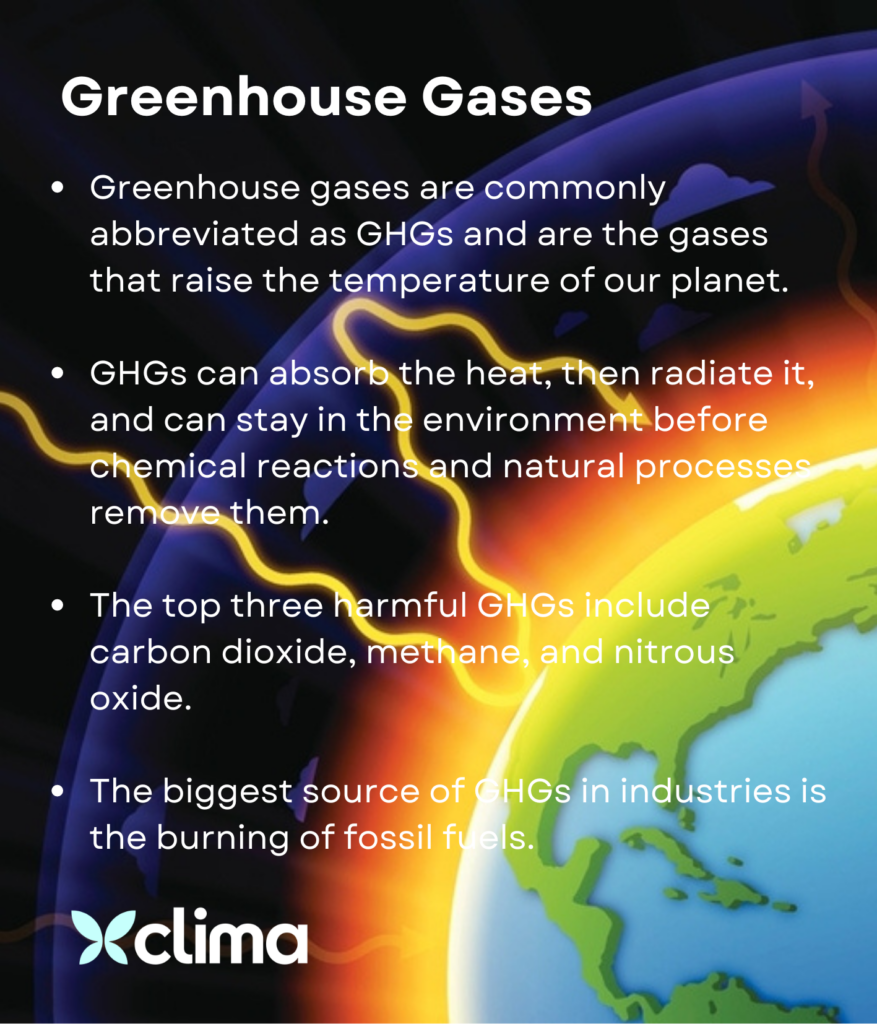Key Points
- Greenhouse gases are commonly abbreviated as GHGs and are the gases that raise the temperature of our planet.
- GHGs can absorb the heat, then radiate it, and can stay in the environment before chemical reactions and natural processes remove them.
- The top three harmful GHGs include carbon dioxide, methane, and nitrous oxide.
- The biggest source of GHGs in industries is the burning of fossil fuels.
Table of Contents
Greenhouse Gases: A Complete Guide
Greenhouse gases are commonly abbreviated as GHGs and are the gases that raise the temperature of our planet. These gases are named after the greenhouse because they mirror the same effect but in the place of a glass building, it’s the gases that form a blanket over the planet, restricting the heat from leaving it. It is quite an interesting phenomenon and the leading cause of globally rising temperatures and its consequent effects.

Normally, the heat from the sun increases the temperature of the planet but this heat is very important for different processes. This heat then dissipates from the atmosphere, maintaining a normal range of temperature, crucial for life on Earth. After the Industrial Revolution, there was a huge boost in the applications of fossil fuels and natural gases. To meet the demand for the products, the industries did whatever they could to keep afloat and running.
This meant that more natural gases and fossil fuels were used and burning them meant more pollution in the atmosphere and a huge amount of by-products. These by-products contain poisonous gases that remain in the atmosphere after formation. These gases then absorb the heat coming from the sun and make a blanket in the atmosphere which does not let any heat escape, all in all, raising the temperature of the planet.
Characteristics of Greenhouse Gases
The two most important characteristics of GHGs are their ability to absorb the heat and radiate it which is referred to as radioactive efficiency and the second is to stay in the environment before chemical reactions and natural processes remove them. These characteristics are measured for each gas to judge their impact on the environment and thus their greenhouse effect.
A measure of the radiative effect of each unit of gas (by weight) over a specified period, expressed relative to the radiative effect of carbon dioxide (CO2) is called the Global Warming Potential (GWP). The specified period is often 100 years but it can be calculated at any time and for any gas. The gases that have a higher GWP will consequently warm the planet at a much higher rate than the gases that have a lower GWP.
List of Greenhouse Gases and Their Sources
Here is a list of mostly commonly known and released GHGs and a few of their important characteristics:
Carbon Dioxide
Carbon dioxide or CO2 is the primary greenhouse gas which is emitted due to human activities and also accounts for the majority of the greenhouse gases worldwide. In the USA, it accounted for 80% of all of their emitted GHGs through human activities in 2022. This gas is part of Earth’s carbon cycle. The humans have tempered with the bodies that naturally process this gas to a non-toxic product, the trees. The major sources of carbon dioxide gas include transportation, electricity, and industries.
Methane
Methane or CH4 is the second most contributing GHG in the world due to human activities. The two biggest sources of methane include leaks from natural gas systems and the raising of livestock. Naturally, methane is also emitted from various products and in the same way is also removed from the environment but due to various human activities, the amount of methane is increased in the atmosphere making it an important greenhouse gas.
Nitrous Oxide
Nitrous oxide or NO2 is the third most abundant and crucially important greenhouse gas. The human activities that emit nitrous oxide include agriculture, fuel combustion, wastewater management, and industrial processes. Like the other greenhouse gases, nitrous oxide is also naturally present in the atmosphere and is part of the Earth’s nitrous cycle which plays an important role in the growth and development of plants and trees.
The other most important greenhouse gases include ozone, chlorofluorocarbons (CFCs and HCFCs), hydrofluorocarbons (HFCs), perfluorocarbons, Sulfur hexafluoride, and Nitrogen tetrafluoride.
What Can Businesses Do About Their GHG Emissions?
Businesses can do a lot about their GHG emissions as they might be their biggest contributors. Clima is one platform that helps companies optimize their supply chain, measure and offset their emissions, and engage with their customer base regarding making environmentally sustainable choices.
They are a reliable source for businesses wanting to buy carbon credits and participate in good carbon projects in Australia and internationally. Their commitment is to drive real progress in reducing carbon emissions in the corporate sector. Clima operates based on core values that guide every initiative we undertake.
FAQs
What Are the Three Most Harmful GHGs?
The top three harmful GHGs include carbon dioxide, methane, and nitrous oxide. The main contributors to these GHGs are human activities and more importantly industries, transportation, livestock, and agriculture. Other than these three GHGS, other gases are ozone, chlorofluorocarbons (CFCs and HCFCs), hydrofluorocarbons (HFCs), perfluorocarbons, Sulfur hexafluoride, and Nitrogen tetrafluoride.
What Is the Biggest Source of GHGs in Industries?
The biggest source of GHGs in industries is the burning of fossil fuels. These fuels are used to run the industries and are therefore important but their burning emits harmful gases as by-products that are the biggest source of rising temperatures on the planet. In contrast to these gases, industries can use sustainable fuels and other sources to run but such a big change takes time and effort.
Conclusion
In conclusion, as the name suggests, the GHGs mimic a greenhouse effect on this planet and are thus increasing the temperature. The GHGs need to be cut down from their sources of industries and livestock if we want to minimize global warming. This can be done by urging industries to use sustainable fuels and by making such fuels easily accessible to them.
Further Reading
- https://www.epa.gov/ghgemissions/overview-greenhouse-gases
- https://www.nationalgrid.com/stories/energy-explained/what-are-greenhouse-gases


